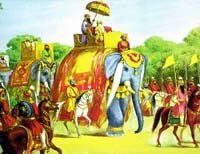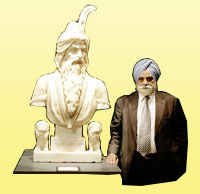200 Years of Maharaja Ranjit Singh
"On the 1st of Baisakh (April 12) 1801, Sahib Singh Bedi daubed Ranjit Singh’s forehead with saffron paste and proclaimed him Maharajah of the Punjab. A royal salute was fired from the fort. In the afternoon the young Maharajah rode on his elephant, showering gold and silver coins on jubilant crowds of his subjects. In the evening, all the homes of the city were illumined. Ranjit Singh’s political acumen is well illustrated in the compromise that he made between becoming a Maharajah and remaining a peasant leader. Although crowned King of the Punjab, he refused to wear the emblem of royalty in his simple turban. He refused to sit on a throne
The most important consequence of taking on the title of "Maharajah of the Punjab" was that thereby Ranjit Singh assumed the rights of sovereignty not only over all Sikhs (the government itself being Sarkar Khalsaji) but over all people who lived within the ill-defined geographical limits of the Punjab."
— Extracted from A History of the Sikhs by Khushwant Singh.

The Glorious Reign
Regrettably, scholars have neglected the use of Persian source-material in their study of Maharaja Ranjit Singh. That is why research work produced and published on him and his times has generally relied on the British sources which are partial and one-sided. A major portion of research studies on him has been brought out by non-professional historians who are ignorant of the Persian language, says V. N. Datta.
The Patron of the Arts
The hallmark of the art of Maharaja Ranjit Singh is thus its truthfulness. It is of the earthly earth. And, in spite of the import of some of the painters from the Pahari courts, the abundance of portraiture shows how almost everyone, including the Maharaja, was in search of an identity in their new exalted status, which they had acquired from modest origins in the villages of the Punjab plains. Thus, every expression under the patronage of Ranjit Singh and his nobles, shows a vitalist urge for freedom to open out to life, and more life, in the midst of things of beauty which may please the eyes, make the heart glow and intensify the emotions, says Mulk Raj Anand
Nature of Ranjit Singh’s polity
A ruler much ahead of his timesThe most notable trait of Ranjit Singh’s polity was the complete freedom of expression and worship enjoyed by all his subjects. Though he was born and brought up in the Sikh faith and listened to the recitation from Sikh scriptures every day, he did not proclaim Sikhism as the religion of the state. He also did not make any conscious effort to propagate it. His broad religious outlook was reflected in his according due respect to all religions. The spirit of forbearance displayed by him was in sharp contrast to the inhuman practices of the Mughal rulers, their plunder, and forced conversions, writes Gurdarshan Singh Dhillon.

How relevant are Ranjit Singh’s ideas today
by Surjit HansAccording to Budh Singh, the ruler is always right; the people wrong. A king lays the people under obligation by ruling over them. If the king does not overlook the fault of the people, the world would stop. In developing countries, leaders coming to power through the modern institutions of electoral democracy, soon revert to pre-modern mentality when faced with a crisis.
Maharaja Ranjit Singh — a visionary
by Prithipal Singh KapurTHE rise of Ranjit Singh in the Punjab was a unique phenomenon. It can in no way be associated with the decline of the Mughal Empire or consequential rise of the provincial satraps in various regions of the Indian sub-continent. However, some historians have attempted to make an odious comparison between Tipu Sultan of Mysore and Ranjit Singh.
Maharaja Ranjit Singh’s Subjugation of North Western Frontier
by Kirpal SinghHari Singh Nalwa knew how to match the Sikh hatred of Afghans. He set up a very strong administration in the Peshawar valley. He levied a cess of Rs 4 per house on the Yusafzais. This cess was to be collected in cash or in kind. For its realisation, personal household property could be appropriated. There was scarcely a village which was not burnt. In such an awe were his visitations held that his name was used by mothers as a term of fright to hush their unruly children.
Jewels and Relics from Maharaja Ranjit Singh's Toshakhana
by Mohinder Singh AFTER consolidating his victories and establishing an independent kingdom in Punjab, Maharaja Ranjit Singh built a unique collection of jewels and relics. The world famous Koh-i-Noor is the most precious in the category of jewels and the Kalgee of Guru Gobind Singh in the category of relics.
